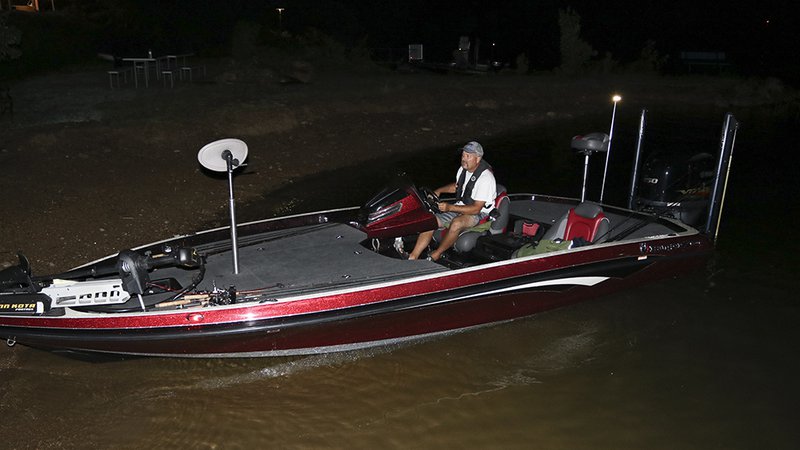Beat the Heat With After Dark Angling
ON 08-02-2017

Aug. 2, 2017
Randy Zellers
Assistant Chief of Communications
Once daytime temperatures stay above that 90-degree mark and pleasure boaters begin to churn up the water, many anglers decide to hang up the rods until cooler days begin to creep into the forecast. Others have learned the best way to beat the heat is to fish during the night shift.
Matt Hedrick and Matt France recently were named Anglers of the Year in the Tuesday night tournament circuit held weekly on Lake Maumelle in Little Rock. Although they’re relatively young compared to many old salts that fish Maumelle, they’ve already learned the benefits of fishing after dark and have been at it for years.
“It’s really not that different from daytime,” Hedrick said. “It’s cooler, so that’s nice, and a lot of fish that weren’t feeding during the day will move up to feed at night, sort of like deer do at the beginning of hunting season.”
The most obvious adjustment anglers need to make is to really get to know your surroundings. One trip on the water after the sun goes down will definitely clue an angler in on how difficult navigation at night can be.
“The freakiest part is that you just can’t see where you’re fishing, so you need to be sure to know your spot and know where you are on the lake when you’re running to your spots,” Hedrick said.
“Really get to know your GPS unit,” France added. “Finding your location, especially offshore stuff is almost impossible without it on a dark night.”
Take a tip from experienced fishermen and prepare everything you can before you launch the boat. Get items in place before leaving home and when you park. Bumping around with gear in the boat on the water wastes time, and it also tends to make unnecessary, fish-alarming noise.
The temptation for first-time night-fishing anglers is to bring along flashlights, lanterns and any other source of light they can find to be able to see better while plying the ink-black waters. Headlamps are helpful, but Hedrick and France advise anglers to use them sparingly.
“The fish don’t need to be able to see the lure, and I like to let my eyes adjust to the darkness as much as possible,” Hedrick said. “We use lights to help tie on a bait or take care of something, but lights attract a lot of insects at night.”
Navigation lights, on the other hand, are essential to staying safe after hours. On non-federal waters, such as Lake Maumelle and AGFC-owned lakes, simply having a lighting source onboard is legal. On federally controlled waters, such as U.S. Army Corps of Engineers reservoirs and navigable rivers, a U.S. Coast Guard-approved anchor light at the stern and red/green navigation bow light must be in operation at all times once the sun goes down.
“Even on Maumelle, we always turn them on while running, and any time a boat is near,” Hedrick said. “There have been some accidents on other lakes in the last few years where boats didn’t have their lights on and were run over by someone who couldn’t see them until it was too late. There’s no need to take that chance just to stay hidden for a tournament.”
Most anglers don’t want to fumble around in the dark, looking for that perfect color or style lure, but you really don’t have to. According to Hedrick, you really only need a handful of options for night fishing and big black baits are the go-to lure choices once the sun goes down.
“Everything needs to be black or dark-colored,” Hedrick said. “The mainstays are always a big, Colorado-bladed spinnerbait most anglers call a ‘spider,’ a black topwater lure, a big black jig and a big black worm. You need baits that put off a lot of vibration, whether it’s with rattles or large soft-plastic bodies, so bass can key in on them.”
Hedrick’s partner France agrees, adding a black buzzbait to his lineup.
“It’s actually a little easier to catch fish on a buzzbait at night,” France said. “You can’t really see the strike as well, so you don’t set the hook too soon when you see a fish follow the bait.”
Caring for fish is just as critical at night as it is during the daytime. Water doesn’t cool as quickly as air temperatures, and those bass are still swimming in bathwater temperatures, so if you’re planning to release the fish later, you have to keep your livewells churning.
“We add ice to the livewells just like daytime tournaments,” Hedrick said. “We try our best to get our fish calmed down and cool to prevent stressing them too much.”
Be sure to bring plenty of water for yourself as well. Eighty-degree nights may feel cool compared to 95-degree days, but it’s still hot enough to work up a sweat when the fishing action cranks up.
Recent News
Subscribe to Our Weekly Newsletter E-mails
Don’t miss another issue. Sign up now to receive the AGFC Wildlife Weekly Newsletter in your mailbox every Wednesday afternoon (Waterfowl Reports are published weekly during waterfowl season and periodically outside the season). Fishing Reports arrive on Thursdays. Fill in the following fields and hit submit. Thanks, and welcome!


